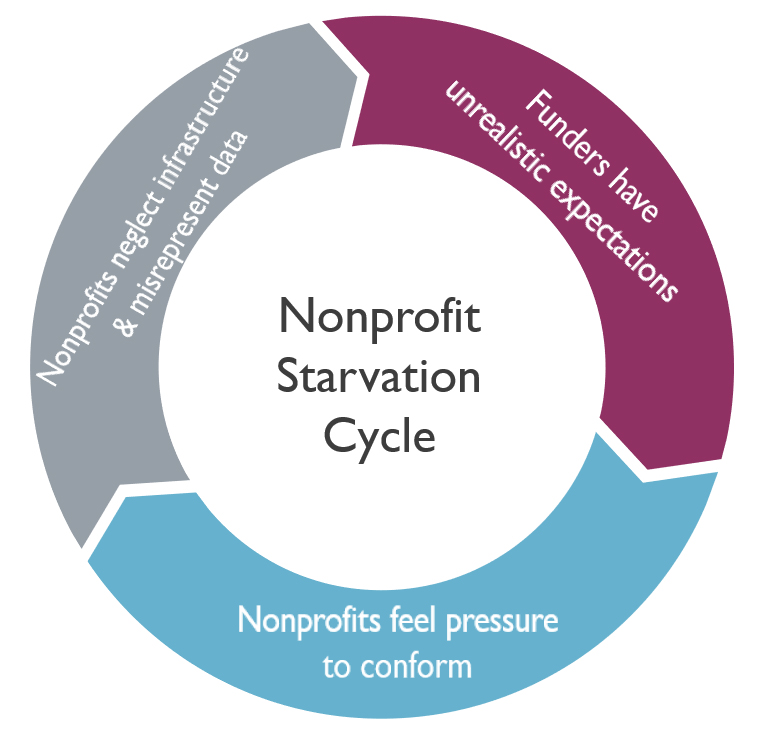The Power of Integrating Brand Strategy Into Your Nonprofit’s Website
October 28, 2022
Courtney Rosenfeld Says, “Start Your Own Nonprofit Marketing Department”
October 30, 2022Nonprofit Starvation Cycle – Avoid It In 2023

Nonprofit Starvation Cycle – Avoid It In 2023 reveals a myth that has been circulating around the nonprofit world for decades. Learn from Jill Foley Turner of the National Christian Foundation. Here’s what Jill has to share:
It goes like this: A charity is only worthy of our money if it spends very little of it on overhead expenses. After two years in a global crisis and a rocky financial year for many, it’s time to debunk this myth and change the way we look at nonprofit organizations.
The truth is – and research has shown that – nonprofits that invest in capacity-building – things like technology, financial systems, skills development, and fundraising – are more likely, not less, to succeed.
This is not news. We know this to be true of just about any organization.
Yet a general rule of thumb still used by many charity-rating organizations is that the best charities spend 25 percent or less on overhead. And, because the myth that low overhead is the mark of a good charity never seems to fall out of fashion, donors want to see this number continue to lower.
A 2012 donor poll conducted by Grey Matter Research showed funders believed a charity should not spend more than 22 percent of its budget on overhead. By 2018, the same question revealed donors preferred overhead spending be 19 percent or less.
The result has been charities deprived of money they need to function. Conforming to expectations of constantly lowering overhead expenses can be a downward spiral. It’s known as the “nonprofit starvation cycle.” (VISIT HERE to learn more.)
Nonprofit Starvation Cycle – Avoid It In 2023
It begins when funders have unreasonable expectations about a nonprofit’s needs and spending. Nonprofit leaders feel they must decrease spending or lose donors. Other nonprofits in the same sector lower their overhead for the same reason, compounding the problem. Infrastructure is neglected, and nonprofit leaders are tempted to produce misleading reports the next time they present to donors. After succumbing to the pressure, charity leaders may face more unreasonable expectations again the next year.
What these donors may be missing is what happens when money is poured into programs without the systems in place to sustain them, without the computers needed to produce donor reports, without the staff needed to hold fundraiser events. The list goes on and on.
It is no surprise that turnover rates in the nonprofit sector are higher than average. (Research in January of 2020 from the company Nonprofit HR reported that 45 percent of nonprofit workers were looking for another job, the majority of them outside the nonprofit world.)
So, what is the right amount for a nonprofit, ministry, or charity to spend on overhead? Well, it depends on the charity.
A food pantry, for example, may not require much overhead, while a charity conducting medical research or a ministry spreading the gospel through high-tech media may need to spend more on things like equipment, facilities, or training. For these, cutting overhead might quickly put them out of business.

Which charities may be most hurt?
Most agree that the nonprofit sector is fairly resilient, having grown consistently over the last two decades, accumulating a collective $1 trillion in net assets and having endured two years of a global pandemic. But the collective picture masks the struggles of smaller nonprofits which were harder hit in a COVID-impacted economy, researchers at Candid report.
These smaller charities (which include many education-related charities, as well as crisis-intervention and mental-health nonprofits) may suffer the most if forced to cut costs at a time when they’re being asked to increase the number of people they serve.
And if they just can’t make the numbers work any longer, they may find themselves left with one option: shut their doors on the people they yearn to serve. “But the people served by shuttered nonprofits face practical consequences that cannot be abstracted away,” Candid says.
There are ways you can be wise with your gifts without furthering the myth and perpetuating the nonprofit starvation cycle.
5 types of questions that can encourage a charity and help you give more wisely
How can you know if a particular nonprofit is a good investment of your charitable dollars? There are better ways to judge than just overhead. Consider taking a step back and getting to know them a little. Then your questions can make you not only a wiser giver, but also a more understanding one.
- Ask more specifically about overhead spending. Questions can be more constructive if you think through what you really want to know. Here are a few ideas: What setbacks have you faced in the last two years; what infrastructure is lacking or in need of improvement? What systems are not in place that need to be? What programs will suffer if you don’t spend more on this budget item? Are you spending on anything you don’t really need? While you don’t want to bombard them with your questions, some of these may help you discover important needs that the charity could use your help meeting.
- Ask about their people? Turnover in nonprofits is higher than in other sectors. How can you help a charity help its people to thrive, so they want to keep working there? Investing in a charity’s people is a great way to make it stronger. What training do employees require, and are they getting it? Does the charity leader need business coaching, counseling, mentoring? How can you help encourage or fund what is needed most for the people working in the causes you care about.
- Ask about financial readiness? Cash reserves are a good way to determine whether a nonprofit is likely to remain resilient in times of uncertainty. Prior to the pandemic, the median nonprofit had about six months of cash reserves, meaning that if they received no income for six months, they could continue their regular activity for that amount of time before having to shut down. Financially stronger organizations with more than a year in cash reserves are better prepared for a storm. However, a sustainable, mature organization will have more reserves than just cash. A diverse funding portfolio is as critical to a nonprofit as it is to an individual. If you are financially savvy, maybe you can help.
- Ask about restricted gifts. Everyone wants to give toward their favorite charity’s mission. Help find homes for orphans. Further the translation of the gospel. Create jobs for the poor, leading to a sustainable life. These are critical, and they’re the reason you’re passionate about the charities you support. But because running a charity also requires paying for things like overhead, grants restricted to mission-only activities can hurt a nonprofit. What percentage do restricted gifts make up of a charity’s total gifts? Is this a problem? Is it a problem you could help other givers understand?
- Ask what you can do, specifically. There is maybe nothing kinder you can do for a charity leader than to ask what they need the most and figure out how to make it happen. What organizational dreams can you help get funded? What skills can you offer to use to serve them? Is there something you could do right away that would absolutely transform the ministry?
There is great benefit to getting to know the charities you support. If your goal is to help, they will likely welcome your support and interest, and you may find they even welcome your questions.
Building these relationships makes false measures of success, like the myth (low overhead=good charity), unnecessary and your experience as a giver more rewarding. And you’ll have done your part to end the nonprofit starvation cycle, perhaps, once and for all.
Nonprofit Starvation Cycle – Avoid It In 2023 was first posted at National Christian Foundation.
For more articles like Nonprofit Starvation Cycle – Avoid It In 2023 please VISIT HERE
Jill Foley-Turner – National Christian Foundation – [email protected]

The post Nonprofit Starvation Cycle – Avoid It In 2023 appeared first on NANOE | Charity’s Official Website.
